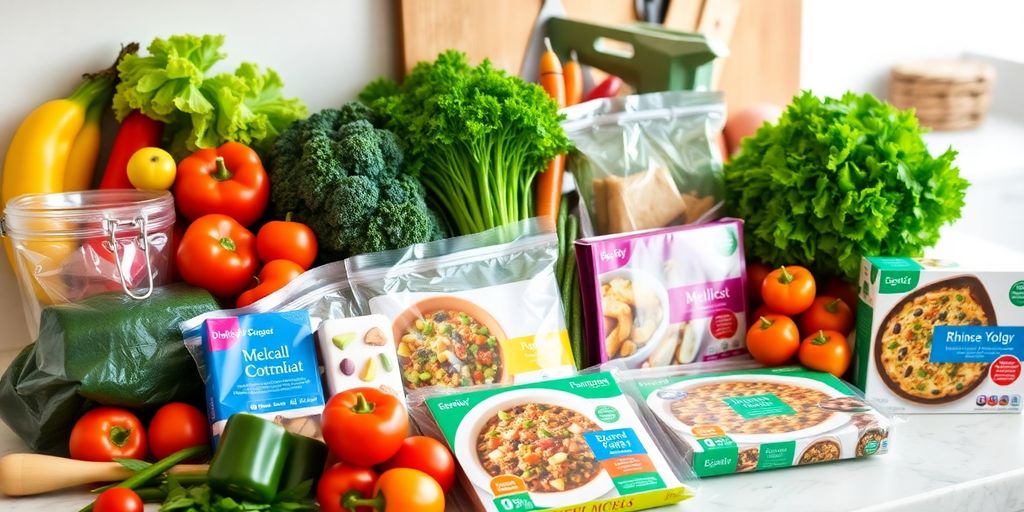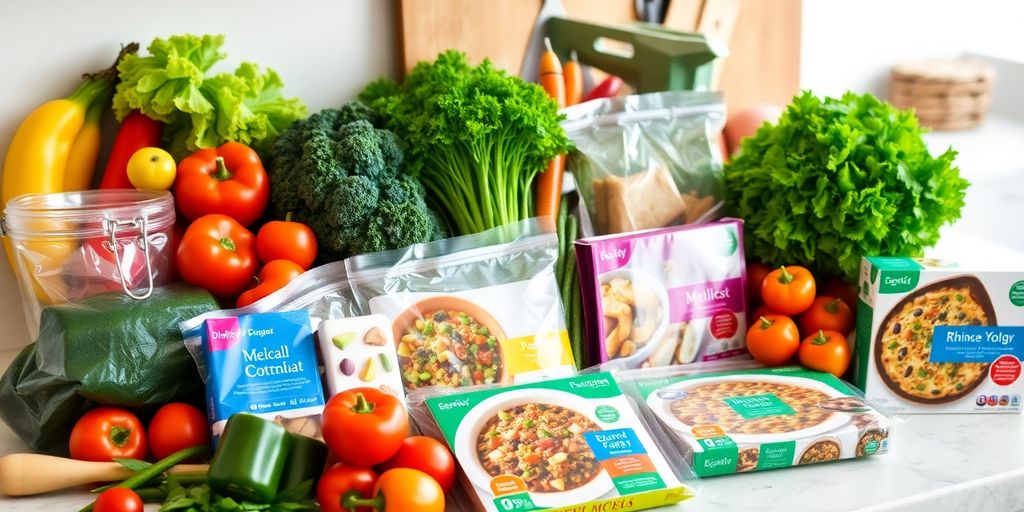Expensive Pet Food Alternatives: Healthy & Affordable Options

If you’re looking for ways to feed your furry friend without breaking the bank, you’re in the right place. In this article, we’ll explore some smart alternatives to expensive pet food that are both healthy and affordable. From fresh dog food options to budget-friendly brands and even homemade recipes, there are plenty of ways to keep your pup happy and healthy without overspending. Let’s dive in!
Key Takeaways
- Fresh dog food can be a great option, but it might cost more than you think when you factor in prep time and ingredients.
- The Honest Kitchen offers affordable dehydrated dog food that provides high-quality nutrition without the high price tag of homemade meals.
- There are many budget-friendly dog food brands that use quality ingredients without cheap fillers.
- Homemade dog food can save money, but it requires careful planning to ensure your dog gets all the nutrients they need.
- Understanding pet food labels helps you avoid harmful additives and choose the best options for your budget.
Exploring Affordable Fresh Dog Food Options

Fresh dog food is gaining popularity, and for good reason! Many pet owners are drawn to the idea of feeding their furry friends real, whole foods. But let’s be honest, those pre-made fresh meals can put a serious dent in your wallet. The global fresh dog food market was valued at over $23 billion in 2023, and it’s not slowing down. So, how can you give your dog the benefits of fresh food without going broke? Let’s explore some options.
Benefits of Fresh Dog Food
Fresh dog food often boasts higher quality ingredients than your average kibble. We’re talking real meat, recognizable veggies, and fewer of those mysterious fillers.
- Improved digestion
- Shinier coat
- Increased energy levels
These are just a few of the perks that owners report when switching to a fresh diet. Plus, many dogs simply find it more palatable, which can be a lifesaver for picky eaters.
Comparing Costs of Fresh vs. Kibble
Okay, let’s get down to brass tacks. Fresh dog food is generally more expensive than kibble. A bag of kibble might last you a month, while those fresh food deliveries come with a higher price tag and more frequent purchases. But it’s not always an apples-to-apples comparison. You need to consider the quality of ingredients. Some premium kibble brands can rival the cost of some fresh options, especially when you factor in subscription services and discounts.
It’s important to do your research and compare the cost per serving, not just the initial price. Look at the ingredients list and nutritional value to see what you’re really getting for your money.
Top Brands for Fresh Dog Food
If you’re set on fresh dog food, there are several brands to consider. Some popular options include:
- JustFoodForDogs
- Nom Nom
- The Farmer’s Dog
These companies deliver pre-portioned, ready-to-serve meals right to your door. However, keep in mind that these services often come with a premium price. Consider alternatives like dehydrated dog food or exploring options from brands like The Honest Kitchen, which can offer a more budget-friendly approach to fresh-like feeding.
The Honest Kitchen’s Cost-Effective Alternatives
When you’re trying to save some money, but still want to give your dog good food, The Honest Kitchen is worth considering. They’ve got some interesting options that are cheaper than fresh food but still way better than your average kibble. It’s like finding a sweet spot between quality and price.
Dehydrated Dog Food
Dehydrated dog food is a pretty cool idea. The Honest Kitchen takes real, whole-food ingredients and gently removes the moisture. This means you get all the nutrients without the need for refrigeration, which cuts down on shipping costs. Plus, it’s super easy to store. Just add water, and you’ve got a meal that’s close to fresh food, but at a fraction of the price. It’s way more convenient than trying to make your own fresh dog food, and probably healthier than a lot of kibble options out there.
Whole Food Clusters
Think of Whole Food Clusters as a healthier, less processed version of kibble. These are made with real ingredients that are gently baked into bite-sized pieces. They’re not extruded like most kibble, so they retain more of their natural nutrients. It’s a convenient way to feed your dog a balanced diet without all the fillers and artificial stuff you find in cheaper brands. Plus, dogs seem to really like them, which is always a bonus.
Nutritional Benefits of Honest Kitchen
Honest Kitchen focuses on using human-grade ingredients, which is a big deal. It means they’re held to a higher standard than regular pet food companies. You won’t find any of the questionable stuff that often ends up in cheaper dog food.
They also use a lot of whole foods, so your dog gets a good mix of vitamins and minerals. It’s all about giving them a diet that’s actually good for them, without breaking the bank. If you compare the ingredients to some of the cheaper brands, you’ll see a huge difference in quality.
Here’s a quick rundown of why Honest Kitchen might be a good choice:
- Real, whole-food ingredients
- Human-grade quality
- No artificial additives or fillers
- More affordable than fresh food diets
Budget-Friendly Dog Food Brands
Identifying Quality Ingredients
When you’re trying to save money on dog food, it’s super important to know what to look for on the label. You want to make sure you’re still giving your dog a food that’s good for them, even if it’s not the most expensive option. Look for real meat as the first ingredient – chicken, beef, or fish. Avoid foods that are packed with fillers like corn, wheat, and soy, as these offer little nutritional value. Quality ingredients are key to keeping your dog healthy and happy without breaking the bank.
Top Rated Inexpensive Brands
Finding a good, affordable dog food can feel like a treasure hunt. There are some brands that consistently get good reviews without costing a fortune. For example, Canidae All Life Stages Chicken Meal and Rice is often highlighted as a great option for dogs of all ages. Here are a few others to consider:
- Purina One
- Nutro Natural Choice
- Pedigree
It’s worth checking out online reviews and comparing ingredient lists to see what works best for your dog’s needs and your budget. Don’t be afraid to try a few different brands to find the perfect fit.
How to Choose Budget-Friendly Options
Choosing a budget-friendly dog food isn’t just about picking the cheapest bag. It’s about finding the best value for your money. Here’s how to do it:
- Compare prices per pound: Sometimes, a bigger bag is cheaper in the long run, but always do the math to be sure.
- Read labels carefully: Make sure the food meets your dog’s nutritional needs.
- Consider store brands: Many store brands offer comparable quality to name brands at a lower price.
Homemade Dog Food: Is It Worth It?

Cost Analysis of Homemade Diets
Okay, so you’re thinking about making your dog’s food at home? It sounds like a great way to save money and know exactly what your furry friend is eating. But let’s be real, it’s not always cheaper. The initial thought is often, "I can buy ingredients in bulk and save a ton!" However, high-quality ingredients can add up fast. Think about it: good protein sources, fresh veggies, and maybe even some supplements to make sure your dog is getting everything they need.
| Item | Estimated Cost |
|---|---|
| Protein (meat) | $3-5/lb |
| Vegetables | $1-3/lb |
| Supplements | $0.50-1/day |
Don’t forget to factor in your time. Prepping, cooking, and portioning take time, and time is money, right?
Nutritional Considerations
Making sure your dog gets all the right nutrients is super important. It’s not as simple as throwing some meat and veggies in a bowl. Dogs need a balanced diet with the right amount of protein, carbs, fats, vitamins, and minerals. A deficiency in any of these can lead to health problems down the road. It’s a good idea to talk to your vet or a pet nutritionist before switching to a homemade diet. They can help you create a meal plan that meets your dog’s specific needs.
Tips for Budget-Friendly Homemade Meals
If you’re set on making your dog’s food, here are a few tips to keep costs down:
- Buy in bulk when possible, especially for things like rice or oats.
- Look for sales on meat and vegetables. Freeze any extras to prevent waste.
- Consider using less expensive protein sources, like eggs or certain cuts of meat.
- Supplement wisely. Don’t overdo it on the supplements; just focus on what your dog actually needs.
Homemade dog food can be a great option, but it requires careful planning and attention to detail. It’s not always cheaper than commercial food, and it’s crucial to ensure your dog is getting all the nutrients they need. If you’re not sure where to start, talk to your vet or a pet nutritionist.
Understanding Pet Food Labels
Decoding Ingredients Lists
Okay, so you’re staring at a pet food label, and it looks like a foreign language, right? Don’t worry, it’s not as complicated as it seems. The first thing to know is that ingredients are listed in order of weight. That means the first few ingredients make up the bulk of the food. So, if you see "chicken" listed first, that’s a good sign. But if you see "corn" or "by-products," you might want to dig a little deeper. It’s also important to be aware of ingredient splitting, where a manufacturer lists several different types of the same ingredient (like "ground corn," "flaked corn," and "corn gluten meal") to make it seem like there’s less corn overall.
Recognizing Quality Certifications
When it comes to pet food, certifications can give you some peace of mind. Look for a statement from the Association of American Feed Control Officials (AAFCO). This statement means the food is formulated to meet the nutritional levels established by AAFCO for a particular life stage (like growth or maintenance). It doesn’t guarantee high-quality ingredients, but it does mean the food is nutritionally complete and balanced. Some brands also have certifications related to organic or non-GMO ingredients, which can be important if you’re looking for those qualities.
Avoiding Harmful Additives
Alright, let’s talk about the stuff you don’t want to see in your pet’s food. Artificial colors, flavors, and preservatives are generally things to avoid. Ingredients like BHA, BHT, and ethoxyquin are preservatives that have raised some concerns. Also, watch out for excessive amounts of fillers like corn, wheat, and soy, especially if they’re at the top of the ingredients list. While some pets tolerate these ingredients just fine, they can be problematic for others, especially those with allergies or sensitivities.
It’s a good idea to research any ingredient you’re unsure about. There are plenty of resources online that can help you understand what different ingredients are and whether they’re beneficial or potentially harmful to your pet.
Saving on Pet Food Without Sacrificing Quality
Finding Discounts and Deals
Hunting for discounts is a great way to save money. Start by checking the websites of major pet food brands directly. Many times, they’ll have coupons or promotional offers that you won’t find anywhere else. Also, sign up for email newsletters from pet supply stores and manufacturers. They often send exclusive deals and early access to sales to their subscribers. Don’t forget to check out online deal sites and coupon aggregators; these can be a goldmine for finding discounts on pet food.
Bulk Buying Strategies
Buying in bulk can significantly reduce the cost per serving of your dog’s food. Larger bags of kibble are almost always cheaper per pound than smaller ones. If you have the storage space, consider buying the biggest bag your dog can reasonably consume before it goes stale. Just make sure to store it properly in an airtight container to maintain freshness. Also, keep an eye out for bulk discounts at warehouse stores or online retailers. Sometimes, they offer deals like "buy two, get one free" or percentage discounts on large orders.
Subscription Services for Savings
Subscription services can be a convenient way to save money on pet food. Many companies offer discounts for setting up recurring deliveries. This not only ensures you never run out of food, but it can also save you a significant amount over time. Compare the prices of different subscription services to find the best deal for your dog’s specific food. Look for services that offer flexibility in delivery schedules and allow you to easily pause or cancel your subscription if needed.
It’s important to remember that saving money shouldn’t come at the expense of your dog’s health. Always prioritize quality ingredients and nutritional value, even when you’re on a budget. Don’t be afraid to switch brands or try new strategies to find the best balance between cost and quality.
Nutritional Needs of Dogs on a Budget
Essential Nutrients for Dogs
Dogs, just like humans, need a balanced diet to thrive. This includes proteins, fats, carbohydrates, vitamins, and minerals. Proteins are vital for muscle development and repair, while fats provide energy and aid in vitamin absorption. Carbohydrates can offer fiber and extra energy, though they aren’t always a necessity. It’s easy to overlook microminerals like calcium, magnesium, potassium, and phosphorus, which are crucial for long-term health. A deficiency in these can lead to serious health problems.
Balancing Diets on a Budget
Balancing your dog’s diet on a budget requires careful planning. It’s about finding affordable sources of essential nutrients. For example, you might consider incorporating less expensive protein sources or supplementing with affordable vitamin and mineral mixes. Remember, the goal is to meet your dog’s nutritional needs without breaking the bank. Don’t forget to check out saving strategies to help you find the best deals.
Consulting with Veterinarians
It’s always a good idea to consult with a veterinarian or a registered veterinary nutritionist, especially when you’re trying to balance your dog’s nutritional needs on a budget. They can help you create a meal plan that meets your dog’s specific dietary requirements and overall wellness. They can also advise on quality ingredients to look for in budget-friendly dog foods.
Creating a DIY diet without proper planning can lead to nutritional deficiencies. Working with a professional ensures your dog gets everything they need, even when you’re watching your wallet.
Wrapping It Up
In the end, feeding your pet well doesn’t have to break the bank. Sure, some fancy pet foods can cost a fortune, but there are plenty of options that keep your furry friend healthy without emptying your wallet. Brands like The Honest Kitchen offer a nice balance of quality and affordability, making it easier to provide nutritious meals without the hefty price tag of homemade diets. Remember, it’s all about finding what works best for your pet and your budget. So, take a little time to explore these alternatives, and you might just find the perfect fit for your pup that keeps both their belly and your wallet happy.
Frequently Asked Questions
What are affordable options for fresh dog food?
There are many budget-friendly fresh dog food brands that offer quality ingredients without breaking the bank. Look for options like dehydrated dog food or whole food clusters.
Is homemade dog food cheaper than store-bought?
Homemade dog food might seem cheaper at first, but when you add up the costs of quality ingredients and your time, it can actually be more expensive than buying ready-made options.
How can I find quality dog food on a budget?
To find good dog food that fits your budget, check the ingredient list for high-quality proteins and avoid brands with fillers. Look for top-rated, affordable brands.
Are cheaper dog foods safe for my pet?
Yes, many lower-priced dog foods can be safe as long as they come from reputable companies that test their products for safety. Avoid brands with low ratings.
What should I look for on dog food labels?
When reading dog food labels, look for real meat as the first ingredient, avoid harmful additives, and check for quality certifications to ensure safety and nutrition.
How can I save money on dog food without sacrificing quality?
You can save on dog food by looking for discounts, buying in bulk, or using subscription services that offer lower prices for regular deliveries.








Responses